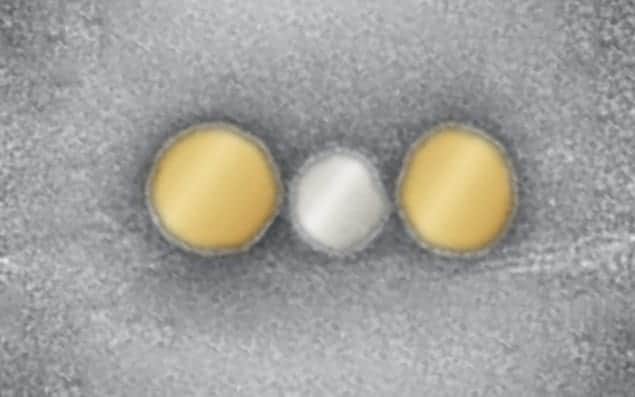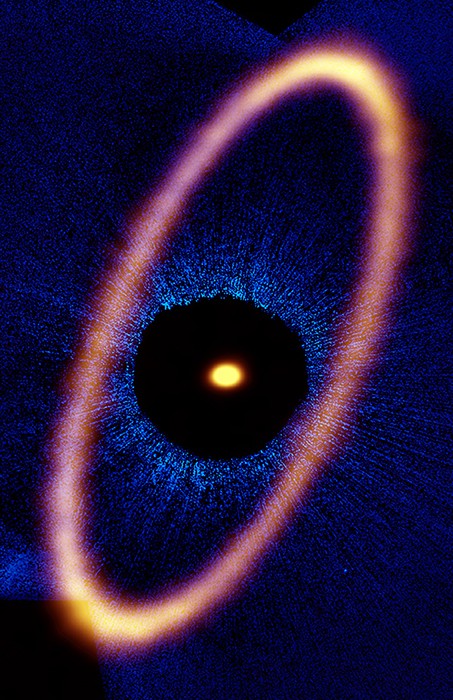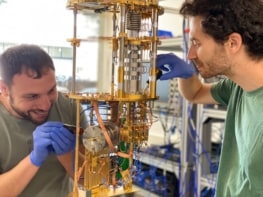Flash Physics is our daily pick of the latest need-to-know developments from the global physics community selected by Physics World‘s team of editors and reporters

Silver boosts optical computers
Tiny particles of silver could boost the performance of tomorrow’s optical computers. That is the claim of Tim Liedl and colleagues at Ludwig-Maximilians-Universitaet in Munich and Alexander Govorov and team at Ohio University, who have shown that the addition of silver nanoparticles to a chain of gold nanoparticles makes the chain much more efficient at conducting plasmons. Computers could be much faster and more energy efficient in the future if they used light to transmit and process information, rather than the electrical signals used today. However, the light that is most efficient at transmitting data over optical fibres has a wavelength greater than 1 μm, which is huge compared to the current size of computer circuits. One way of creating tiny optical circuits is to “shrink” the wavelength of the light by converting it into a plasmon – an oscillation in the conduction electrons of a metal that occurs when the material interacts with light. Once converted to plasmons, data within an optical signal could be processed in high-density chips. Plasmons can be conducted through a circuit using a chain of tiny gold particles, with diameters measuring just tens of nanometres. One problem, however, is that plasmon transmission in gold results in the generation of a significant amount of heat – making such conductors no more efficient than those found in conventional computer circuits. Liedl, Govorov and colleagues have shown that putting a silver nanoparticle (diameter 30 nm) between two gold nanoparticles (diameters 40 nm) results in plasmons being conducted along the chain with almost no energy lost to heat. The research is described in Nature Physics.
Solar-system-like debris spotted around young star

An icy debris ring surrounding a neighbouring planetary system has a chemical kinship with solar-system comets. An international team reached this conclusion after making the first complete image of the rubble ring using the Atacama Large Millimeter/submilimeter Array (ALMA) in Chile. The planetary system is 25 light-years from Earth and a tenth the age of the solar system. Orbiting Fomalhaut – a young star with twice the mass of the Sun – the system contains one of only 20 planets that scientists have imaged directly. Debris rings are common features for young stars and are thought to be caused by collisions between comets and planetesimals during the system’s chaotic early life. Light from Fomalhaut is absorbed by the rubble and re-emitted as radio waves before being captured by ALMA. The new image shows Fomalhaut’s ring in full, revealing an elongated band of icy dust. “We can finally see the well-defined shape of the disc, which may tell us a great deal about the underlying planetary system responsible for its highly distinctive appearance,” says Meredith MacGregor of the Harvard-Smithsonian Center for Astrophysics in the US. The researchers estimate the band is about two billion km wide and around 20 billion km from Fomalhaut. They also found that the ring’s relative abundance of carbon monoxide and carbon dioxide resembles comets found in the solar system. This suggests the system is going through its own Late Heavy Bombardment – a period four billion years ago when the solar-system planets were frequently struck by asteroids and comets left over from the system’s formation. Two papers presenting the work have been accepted for publication in The Astrophysical Journal.
Former US energy secretary joins fusion power firm

The nuclear physicist and former head of the US Department of Energy (DOE) Ernest Moniz has joined the board of directors of Tri Alpha Energy. Based in Foothill Ranch, California, the privately held company is trying to develop an “aneutronic” fusion power system that is based on nuclear-fusion reactions that do not produce large amounts of neutrons. If it can be made to produce energy on a commercial scale, the company’s ion-beam-based system would not have to contend with the damaging neutron radiation that would be generated in other fusion power schemes. Moniz served as US energy secretary under Barack Obama in 2013–2017 and is currently an emeritus professor of physics and engineering at the Massachusetts Institute of Technology.



